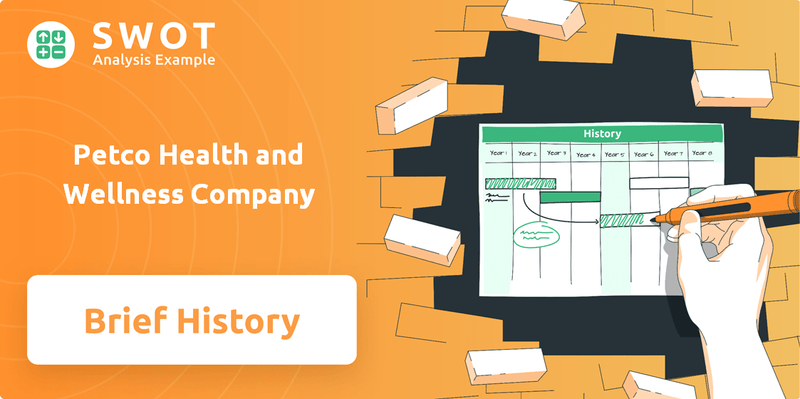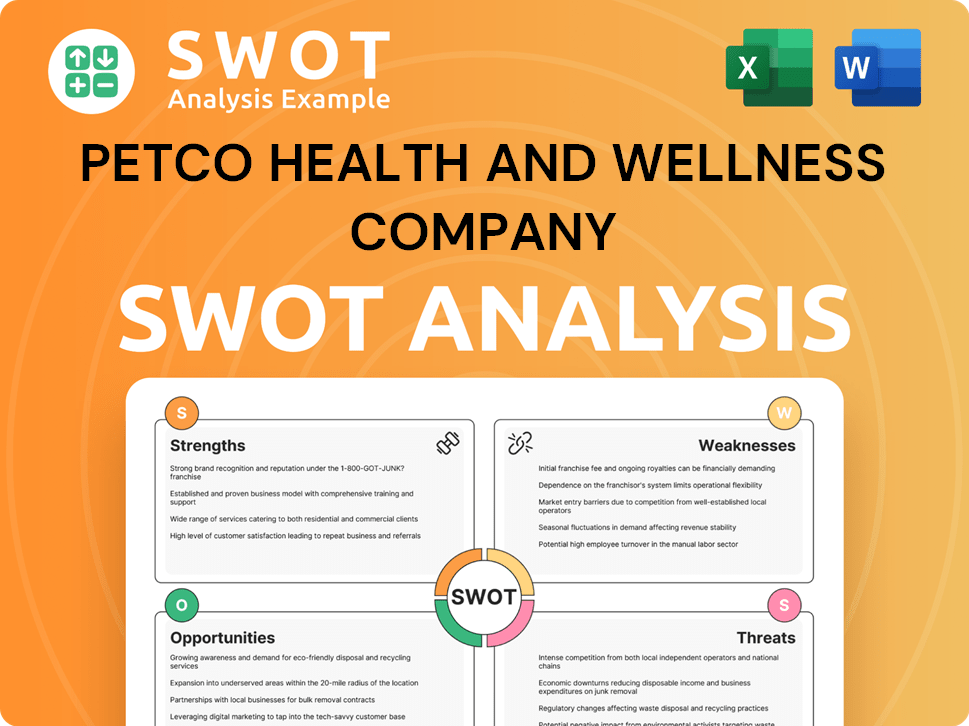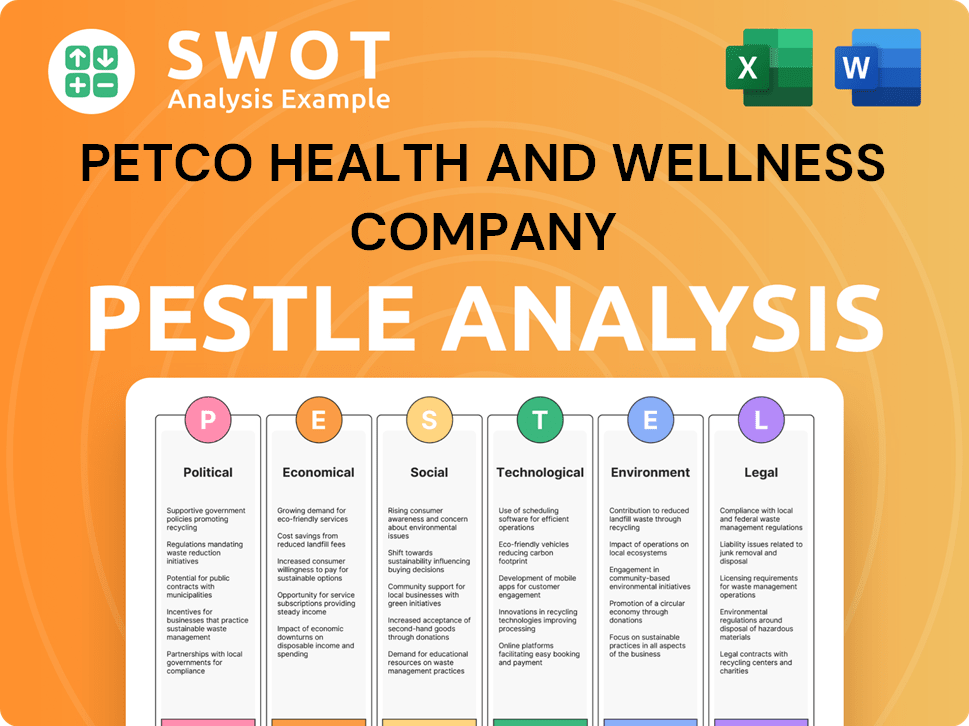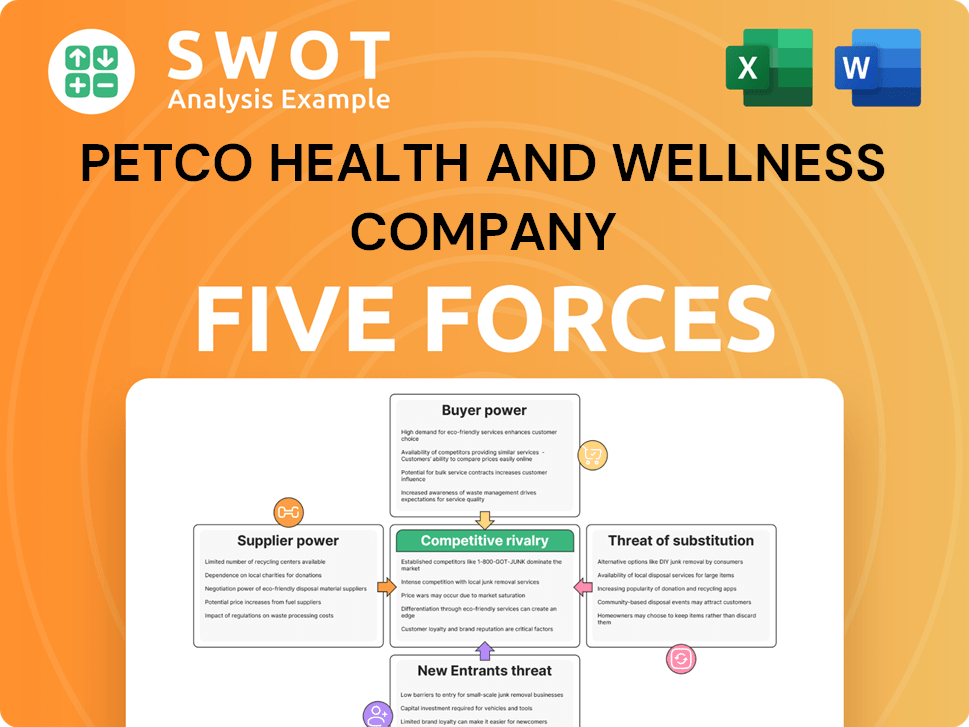Petco Health and Wellness Company Bundle
How has Petco Transformed the Pet Care Industry?
From its humble beginnings in 1965 as a mail-order veterinary supply business, Petco Health and Wellness Company has become a leading force in the pet care market. Founded in San Diego County, California, by Walter Evans, the company's commitment to pet well-being has been a constant throughout its history. Today, Petco boasts a vast network of stores and a strong online presence, offering a wide range of services and products.

This Petco Health and Wellness Company SWOT Analysis provides a detailed look at the company's journey, from its early years to its current status as a publicly traded entity. The Petco history reveals a dynamic Petco evolution in response to changing consumer demands and market trends, including significant Petco acquisitions. Explore the Petco timeline and discover how this company, shaped by its Petco founder and leadership, continues to adapt and grow in a competitive landscape.
What is the Petco Health and Wellness Company Founding Story?
The Petco history began in 1965, marking the start of a significant journey in the pet industry. The company, now known as Petco Health and Wellness Company, has evolved substantially from its early days. This evolution reflects strategic decisions and market adaptations over several decades.
The Petco timeline showcases a transformation from a mail-order business to a national retail chain. The company's story is one of growth, acquisitions, and a commitment to the well-being of pets and their owners. Understanding its origins provides context for its current market position and future aspirations.
In 1965, Walter Evans, a co-owner of a pet supply distributor, founded a mail-order veterinary supply business in San Diego County, California. This marked the beginning of what would become Petco Health and Wellness Company. Initially, the company operated under the name United Pharmacal Company (UPCO).
- Evans, with a team of five associates, served as the first CEO, focusing on providing accessible veterinary products.
- The business model centered on direct-to-consumer sales via mail order, a common approach in the early days of the pet supply industry.
- The name changed to Petco in 1979, reflecting a shift toward a broader market presence.
The Petco evolution continued with the opening of its first retail store in La Mesa, California, in 1976. This transition from mail-order to brick-and-mortar retail was a crucial step in the company's growth. This expansion allowed Petco to reach more customers and increase its product offerings.
A significant period of Petco acquisitions occurred in 1988. The company acquired two pet supply chains, WellPoint and The Pet Department. This strategic move significantly increased its footprint.
- The acquisitions more than tripled the number of stores, expanding from 40 to 130.
- This expansion extended its reach into Oregon, Washington, and Texas.
- The introduction of live fish and small animals in stores diversified its offerings, attracting a broader customer base.
These early expansions were key in establishing Petco as a major regional player. In 2023, the company reported net sales of approximately $6.2 billion, demonstrating its continued presence in the market. For more information about the people behind the company, check out Owners & Shareholders of Petco Health and Wellness Company.
Petco Health and Wellness Company SWOT Analysis
- Complete SWOT Breakdown
- Fully Customizable
- Editable in Excel & Word
- Professional Formatting
- Investor-Ready Format

What Drove the Early Growth of Petco Health and Wellness Company?
The early growth and expansion of the Petco Health and Wellness Company marked a pivotal period in its development. Following its rebranding in 1979, the company began its journey of expansion. This period saw the company transition from a regional player to a national leader in the pet care industry.
The company's expansion outside of California started in 1980 with a store in Tigard, Oregon. A significant boost came in 1988 with the acquisitions of WellPoint and The Pet Department, increasing its store count significantly. This strategic move expanded its presence across the West Coast and into Texas, setting the stage for future growth.
In the late 1980s, the introduction of live animals, starting with fish, added a new dimension to the business model. By 1992, the company made its first move to the East Coast, opening a store in New Jersey. This expansion demonstrated a commitment to becoming a nationwide enterprise, crucial for the company's evolution.
The company went public in 1994, listing on NASDAQ under the symbol PETC. By then, it had become the largest pet specialty retail chain with 218 stores across 13 states and sales exceeding $189 million. This IPO provided capital for aggressive expansion, with the opening of 20 to 50 stores annually between 1990 and 1995.
By 1995, alongside PetSmart, the company had become a major player in the pet food and supply market, offering services like obedience training and grooming. In 1997, it launched PALS, the pet industry's first customer loyalty program. Despite facing financial challenges in the late 1990s, the company showed resilience.
Petco Health and Wellness Company PESTLE Analysis
- Covers All 6 PESTLE Categories
- No Research Needed – Save Hours of Work
- Built by Experts, Trusted by Consultants
- Instant Download, Ready to Use
- 100% Editable, Fully Customizable

What are the key Milestones in Petco Health and Wellness Company history?
The Petco history showcases significant milestones in its evolution, reflecting its growth and adaptation within the pet industry.
| Year | Milestone |
|---|---|
| 1994 | Initial Public Offering (IPO) marked a significant step in the company's expansion. |
| 1995 | Introduction of grooming services nationwide, broadening service offerings. |
| 1997 | Launch of PALS, the pet industry's first customer loyalty program. |
| 1999 | Establishment of Petco Love (formerly Petco Foundation), formalizing its commitment to animal welfare. |
| 2004 | Secured naming rights for the San Diego Padres' baseball stadium, opening as Petco Park. |
| 2008 | Expanded its physical presence to all 50 U.S. states with the opening of a Hawaii store. |
| 2021 | Re-entered the public market. |
Innovations have been a core part of the
The introduction of grooming services nationwide in 1995 was a pioneering move, expanding service offerings beyond retail products. This innovation enhanced customer convenience and experience.
Launched in 1997, PALS was the pet industry's first customer loyalty program, fostering customer retention. This program provided incentives and rewards, building customer loyalty.
The creation of Petco Love (formerly Petco Foundation) in 1999 formalized the company's commitment to animal welfare. This initiative supports animal shelters and rescue organizations.
Expanding its veterinary footprint is a key strategic move, enhancing the company's service offerings. This expansion aims to provide comprehensive pet care solutions.
Enhancing digital and e-commerce capabilities is crucial for adapting to market trends. This includes improving online shopping experiences and delivery options.
Petco has been strategically repositioning itself to improve operational efficiencies. This involves optimizing product assortments and promotional strategies.
Despite these achievements,
The company has navigated market downturns, particularly in consumer spending, impacting sales. Weaker consumer spending has affected sales, especially in supplies and companion animals.
Facing competition is an ongoing challenge, requiring continuous adaptation and innovation. Competition from various retailers and online platforms necessitates strategic adjustments.
In 2024, net revenue was $6.1 billion, a 2.2% decrease year-over-year, with a GAAP net loss of $101.8 million. Despite these figures, comparable sales increased by 0.3% year-over-year.
Improving operational efficiencies is a key focus, including optimizing product assortment and promotional strategies. This involves streamlining operations and enhancing profitability.
Costs associated with strategic repositioning, including net closures of pet care centers, impact profitability. The company plans to close a net of 20-30 stores in 2025.
Leadership changes and strategic overhauls reflect the company's efforts to adapt to market challenges. CEO Joel Anderson noted that 'foundational practices' needed overhauling in early 2025.
Petco Health and Wellness Company Business Model Canvas
- Complete 9-Block Business Model Canvas
- Effortlessly Communicate Your Business Strategy
- Investor-Ready BMC Format
- 100% Editable and Customizable
- Clear and Structured Layout

What is the Timeline of Key Events for Petco Health and Wellness Company?
The Petco Health and Wellness Company has a rich history, evolving from a mail-order business to a leading pet care retailer. The company's journey includes significant milestones, such as its initial public offerings, strategic acquisitions, and expansions that have shaped its presence in the pet industry. Key events in the company’s history showcase its commitment to innovation and comprehensive pet care, reflecting its adaptability to market changes.
| Year | Key Event |
|---|---|
| 1965 | Founded as a mail-order veterinary supply company in San Diego County, California. |
| 1976 | Opened its first retail store in La Mesa, California. |
| 1979 | Rebranded from United Pharmacal Company (UPCO) to Petco. |
| 1988 | Made key Petco acquisitions, including WellPoint and The Pet Department, expanding to 130 stores. |
| 1994 | Went public on NASDAQ (PETC), becoming the largest pet specialty retail chain with 218 stores. |
| 1995 | Rolled out grooming services nationwide. |
| 1997 | Launched PALS, the pet industry's first customer loyalty program. |
| 1999 | Founded Petco Love (formerly Petco Foundation). |
| 2000 | Taken private in a $600 million leveraged buyout. |
| 2002 | Went public for the second time on NASDAQ (PETC). |
| 2004 | Petco Park, the San Diego Padres' baseball stadium, opened with Petco naming rights. |
| 2008 | Expanded into all 50 U.S. states with a store opening in Hawaii. |
| 2010 | Partnered with Petco Love to launch the first National Pet Food Bank. |
| 2013 | Introduced WholePets, focusing on pets' physical, mental, social, and emotional needs. |
| 2021 | Held its third IPO, listed on NASDAQ under the ticker WOOF. |
Petco is focused on a multi-year turnaround effort to drive sustainable growth. The company anticipates double-digit adjusted EBITDA improvement in 2025. Strategic initiatives include enhancing operational efficiencies and strengthening omnichannel capabilities.
For 2025, Petco projects a revenue decline in the low single digits. Adjusted EBITDA is expected to be between $375 million and $390 million, an increase from $336.5 million in 2024. The company plans to close between 20 and 30 net locations in 2025.
Petco aims to expand its veterinary footprint and digital capabilities. They are also optimizing their product assortment and store labor model. The company is focused on deepening competitive advantages through its comprehensive pet health and wellness ecosystem.
The broader pet care market is expected to grow significantly, driven by increasing pet ownership and wellness focus. E-commerce in the pet care market is projected to reach $129.5 billion by 2030. Petco's long-term strategy includes scaling services and enhancing merchandise offerings.
Petco Health and Wellness Company Porter's Five Forces Analysis
- Covers All 5 Competitive Forces in Detail
- Structured for Consultants, Students, and Founders
- 100% Editable in Microsoft Word & Excel
- Instant Digital Download – Use Immediately
- Compatible with Mac & PC – Fully Unlocked

Related Blogs
- What is Competitive Landscape of Petco Health and Wellness Company Company?
- What is Growth Strategy and Future Prospects of Petco Health and Wellness Company Company?
- How Does Petco Health and Wellness Company Company Work?
- What is Sales and Marketing Strategy of Petco Health and Wellness Company Company?
- What is Brief History of Petco Health and Wellness Company Company?
- Who Owns Petco Health and Wellness Company Company?
- What is Customer Demographics and Target Market of Petco Health and Wellness Company Company?
Disclaimer
All information, articles, and product details provided on this website are for general informational and educational purposes only. We do not claim any ownership over, nor do we intend to infringe upon, any trademarks, copyrights, logos, brand names, or other intellectual property mentioned or depicted on this site. Such intellectual property remains the property of its respective owners, and any references here are made solely for identification or informational purposes, without implying any affiliation, endorsement, or partnership.
We make no representations or warranties, express or implied, regarding the accuracy, completeness, or suitability of any content or products presented. Nothing on this website should be construed as legal, tax, investment, financial, medical, or other professional advice. In addition, no part of this site—including articles or product references—constitutes a solicitation, recommendation, endorsement, advertisement, or offer to buy or sell any securities, franchises, or other financial instruments, particularly in jurisdictions where such activity would be unlawful.
All content is of a general nature and may not address the specific circumstances of any individual or entity. It is not a substitute for professional advice or services. Any actions you take based on the information provided here are strictly at your own risk. You accept full responsibility for any decisions or outcomes arising from your use of this website and agree to release us from any liability in connection with your use of, or reliance upon, the content or products found herein.